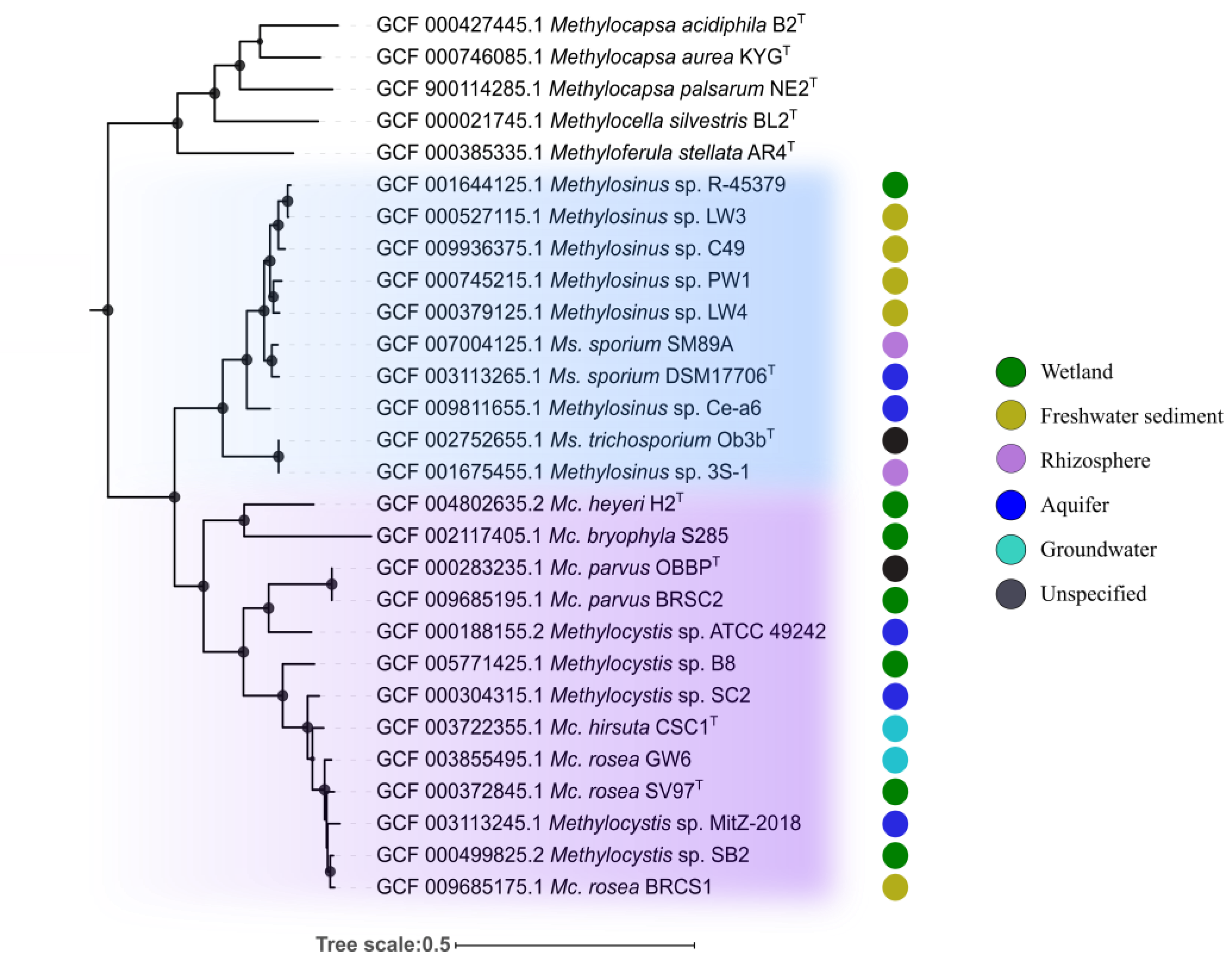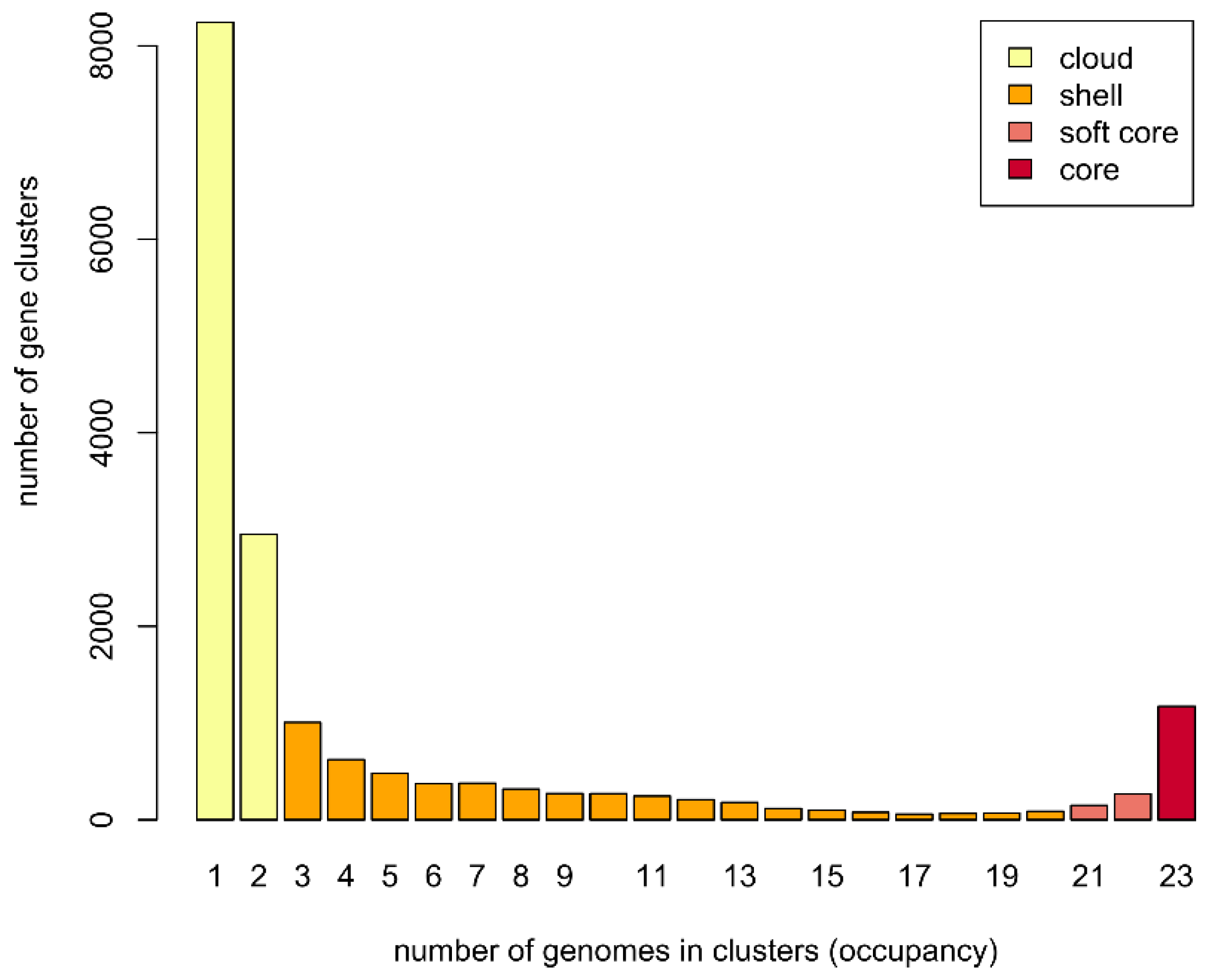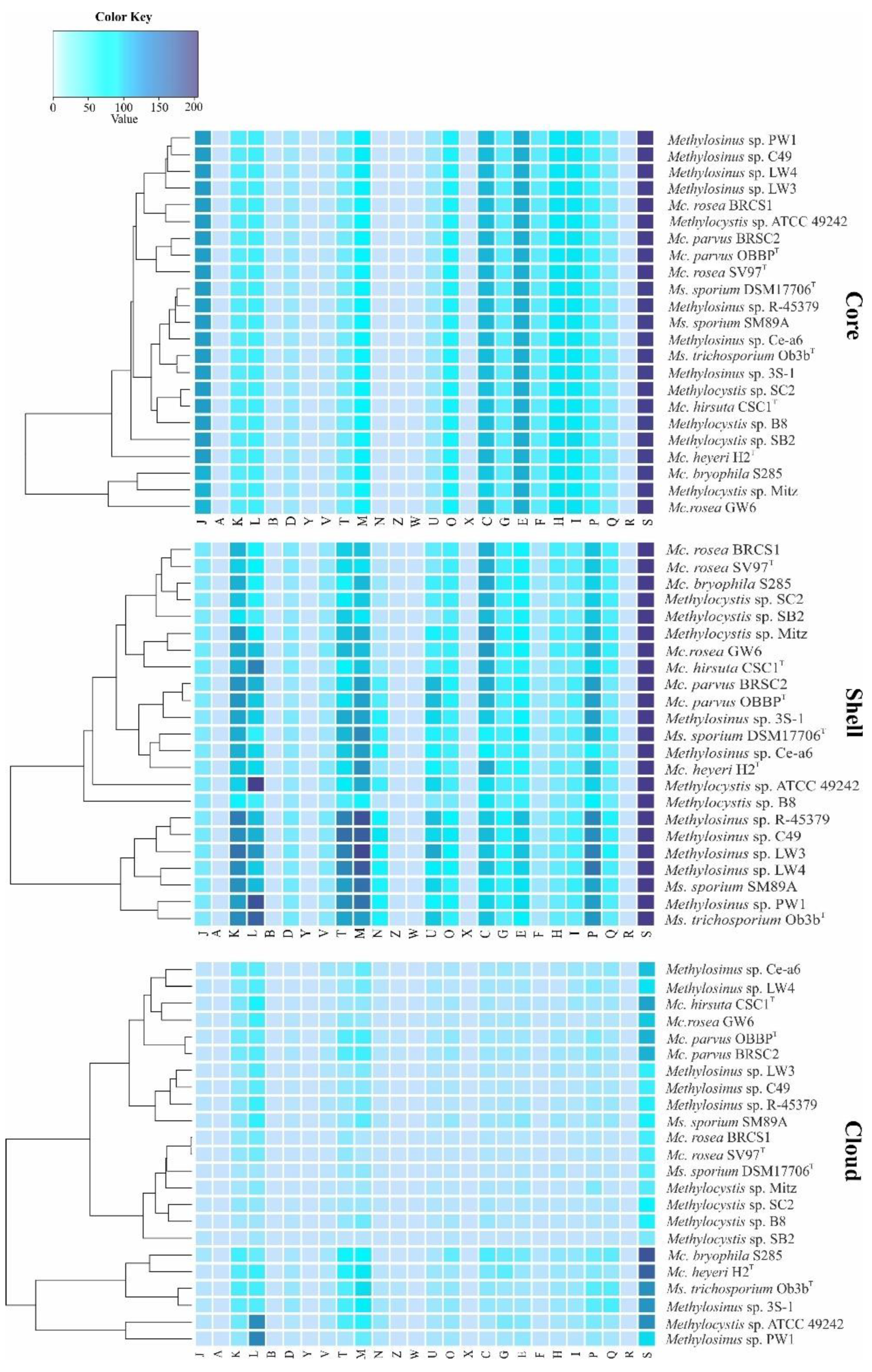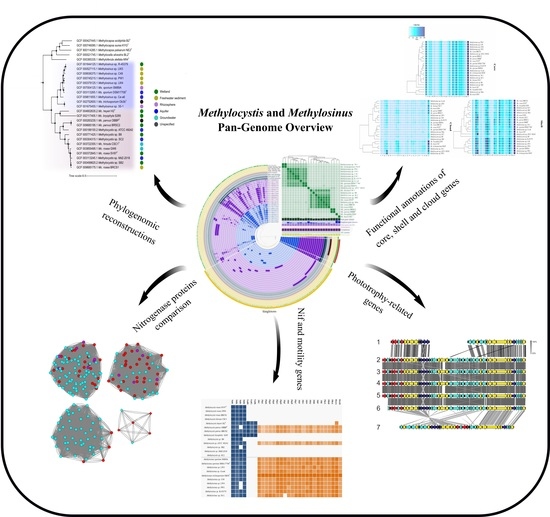Pan-Genome-Based Analysis as a Framework for Demarcating Two Closely Related Methanotroph Genera Methylocystis and Methylosinus
Abstract
1. Introduction
2. Materials and Methods
2.1. Cultivation Procedure and DNA Extraction
2.2. Genome Sequencing and Assembly
2.3. Selection of Reference Genomes and Phylogenomic Analysis
2.4. Core- and Pan-Genome Analysis
2.5. Analysis of Functional Genes
3. Results
3.1. Genome Characteristics of Mc. heyeri H2T
3.2. Genome-Based Phylogeny
3.3. Pan-Genome Analysis
3.4. MMO-Encoding Genes
3.5. Nitrogenase-Encoding Genes
3.6. Genomic Determinants of Flagella-Based Motility
3.7. Phototrophy-Related Genes
4. Discussion
Supplementary Materials
Author Contributions
Funding
Conflicts of Interest
References
- Hanson, R.; Hanson, T. Methanotrophic bacteria. Microbiol. Rev. 1996, 60, 439–471. [Google Scholar] [CrossRef]
- Trotsenko, Y.A.; Murrell, J.C. Metabolic aspects of aerobic obligate methanotrophy. Adv. Appl. Microbiol. 2008, 63, 183–229. [Google Scholar] [PubMed]
- Chistoserdova, L.; Lidstrom, M.E. Aerobic Methylotrophic Prokaryotes. In The Prokaryotes: Prokaryotic Physiology and Biochemistry; Rosenberg, E., Delong, E., Lory, S., Stackebrandt, E., Thompson, F., Eds.; Springer-Verlag: Berlin/Heidelberg, Germany, 2013; pp. 267–285. ISBN 9783642301414. [Google Scholar]
- Khmelenina, V.N.; Murrell, J.C.; Smith, T.J.; Trotsenko, Y.A. Physiology and Biochemistry of the Aerobic Methanotrophs. In Aerobic Utilization of Hydrocarbons, Oils and Lipids. Handbook of Hydrocarbon and Lipid Microbiology; Rojo, F., Ed.; Springer: Cham, Switzerland, 2018; pp. 1–25. ISBN 9783319397825. [Google Scholar]
- Lieberman, R.L.; Rosenzweig, A.C. Crystal structure of a membrane-bound metalloenzyme that catalyses the biological oxidation of methane. Nature 2005, 434, 177–182. [Google Scholar] [CrossRef] [PubMed]
- Hakemian, A.S.; Rosenzweig, A.C. The Biochemistry of Methane Oxidation. Annu. Rev. Biochem. 2007, 76, 223–241. [Google Scholar] [CrossRef] [PubMed]
- Dedysh, S.N.; Knief, C. Diversity and phylogeny of described aerobic methanotrophs. In Methane Biocatalysis: Paving the Way to Sustainability; Kalyuzhnaya, M., Xing, X., Eds.; Springer: Cham, Switzerland, 2018; pp. 17–42. ISBN 9783319748665. [Google Scholar]
- Sharp, C.E.; Smirnova, A.V.; Graham, J.M.; Stott, M.B.; Khadka, R.; Moore, T.R.; Grasby, S.E.; Strack, M.; Dunfield, P.F. Distribution and diversity of Verrucomicrobia methanotrophs in geothermal and acidic environments. Environ. Microbiol. 2014, 16, 1867–1878. [Google Scholar] [CrossRef]
- van Teeseling, M.C.F.; Pol, A.; Harhangi, H.R.; van der Zwart, S.; Jetten, M.S.M.; Op den Camp, H.J.M.; van Niftrik, L. Expanding the verrucomicrobial methanotrophic world: Description of three novel species of Methylacidimicrobium gen. nov. Appl. Environ. Microbiol. 2014, 80, 6782–6791. [Google Scholar] [CrossRef]
- Whittenbury, R.; Phillips, K.C.; Wilkinson, J.F. Enrichment, Isolation and Some Properties of Methane-utilizing Bacteria. J. Gen. Microbiol. 1970, 61, 205–218. [Google Scholar] [CrossRef]
- Bowman, J. The methanotrophs – the families Methylococcaceae and Methylocystaceae. In The Prokaryotes; Dworkin, M., Ed.; Springer: New York, NY, USA, 2006; pp. 266–289. ISBN 0387307435. [Google Scholar]
- Bowman, J.P. Methylosinus. In Bergey’s Manual of Systematics of Archaea and Bacteria; Whitman, W.B., Rainey, F., Kämpfer, P., Trujillo, M., Chun, J., DeVos, P., Hedlund, B., Dedysh, S., Eds.; Wiley: Hoboken, NJ, USA, 2015; ISBN 9781118960608. [Google Scholar]
- Bowman, J.P. Methylocystis. In Bergey’s Manual of Systematics of Archaea and Bacteria; Whitman, W.B., Rainey, F., Kämpfer, P., Trujillo, M., Chun, J., DeVos, P., Hedlund, B., Dedysh, S., Eds.; Wiley: Hoboken, NJ, USA, 2015; ISBN 9781118960608. [Google Scholar]
- Bowman, J.P.; Sly, L.T.; Nichols, P.D.; Hayward, A.C. Revised taxonomy of the methanotrophs: Description of Methylobacter gen. nov., emendation of Methylococcus, validation of Methylosinus and Methylocystis species, and a proposal that the family Methylococcaceae includes only the group I methanotrophs. Int. J. Syst. Bacteriol. 1993, 43, 735–753. [Google Scholar] [CrossRef]
- Wartiainen, I.; Hestnes, A.G.; McDonald, I.R.; Svenning, M.M. Methylocystis rosea sp. nov., a novel methanotrophic bacterium from Arctic wetland soil, Svalbard, Norway (78° N). Int. J. Syst. Evol. Microbiol. 2006, 56, 541–547. [Google Scholar] [CrossRef]
- Dedysh, S.N.; Belova, S.E.; Bodelier, P.L.E.; Smirnova, K.V.; Khmelenina, V.N.; Chidthaisong, A.; Trotsenko, Y.A.; Liesack, W.; Dunfiel, P.F. Methylocystis heyeri sp. nov., a novel type II methanotrophic bacterium possessing “signature” fatty acids of type I methanotrophs. Int. J. Syst. Evol. Microbiol. 2007, 57, 472–479. [Google Scholar] [CrossRef]
- Lindner, A.S.; Pacheco, A.; Aldrich, H.C.; Staniec, A.C.; Uz, I.; Hodson, D.J. Methylocystis hirsuta sp. nov., a novel methanotroph isolated from a groundwater aquifer. Int. J. Syst. Evol. Microbiol. 2007, 57, 1891–1900. [Google Scholar] [CrossRef] [PubMed]
- Belova, S.E.; Kulichevskaya, I.S.; Bodelier, P.L.E.; Dedysh, S.N. Methylocystis bryophila sp. nov., a facultatively methanotrophic bacterium from acidic Sphagnum peat, and emended description of the genus Methylocystis (ex Whittenbury et al. 1970) Bowman et al. 1993. Int. J. Syst. Evol. Microbiol. 2013, 63, 1096–1104. [Google Scholar] [CrossRef]
- Auman, A.J.; Stolyar, S.; Costello, A.M.; Lidstrom, M.E. Molecular characterization of methanotrophic isolates from freshwater lake sediment. Appl. Environ. Microbiol. 2000, 66, 5259–5266. [Google Scholar] [CrossRef] [PubMed]
- Heyer, J.; Galschenko, V.F.; Dunfield, P.F. Molecular phylogeny of type II methane-oxidizing bacteria isolated from various environments. Microbiology 2002, 148, 2831–2846. [Google Scholar] [CrossRef] [PubMed]
- Dunfield, P.F.; Yimga, M.T.; Dedysh, S.N.; Berger, U.; Liesack, W.; Heyer, J. Isolation of a Methylocystis strain containing a novel pmoA-like gene. FEMS Microbiol. Ecol. 2002, 41, 17–26. [Google Scholar] [CrossRef] [PubMed]
- Reuß, J.; Rachel, R.; Kämpfer, P.; Rabenstein, A.; Küver, J.; Dröge, S.; König, H. Isolation of methanotrophic bacteria from termite gut. Microbiol. Res. 2015, 179, 29–37. [Google Scholar] [CrossRef] [PubMed]
- McDonald, I.R.; Murrell, J.C. The particulate methane monooxygenase gene pmo A and its use as a functional gene probe for methanotrophs. FEMS Microbiol. Lett. 1997, 156, 205–210. [Google Scholar] [CrossRef]
- Horz, H.-P.; Yimga, M.T.; Liesack, W. Detection of Methanotroph Diversity on Roots of Submerged Rice Plants by Molecular Retrieval of pmoA, mmoX, mxaF, and 16S rRNA and Ribosomal DNA, Including pmoA-Based Terminal Restriction Fragment Length Polymorphism Profiling. Appl. Environ. Microbiol. 2001, 67, 4177–4185. [Google Scholar] [CrossRef]
- Knief, C.; Lipski, A.; Dunfield, P.F. Diversity and Activity of Methanotrophic Bacteria. Am. Soc. Microbiol. 2003, 69, 6703–6714. [Google Scholar]
- Knief, C.; Kolb, S.; Bodelier, P.L.E.; Lipski, A.; Dunfield, P.F. The active methanotrophic community in hydromorphic soils changes in response to changing methane concentration. Environ. Microbiol. 2006, 8, 321–333. [Google Scholar] [CrossRef]
- Chen, Y.; Dumont, M.G.; Cebron, A.; Murrell, J.C. Identification of active methanotrophs in a landfill cover soil through detection of expression of 16S rRNA and functional genes. Environ. Microbiol. 2007, 9, 2855–2869. [Google Scholar] [CrossRef] [PubMed]
- Nauer, P.A.; Dam, B.; Liesack, W.; Zeyer, J.; Schroth, M.H. Activity and diversity of methane-oxidizing bacteria in glacier forefields on siliceous and calcareous bedrock. Biogeosciences 2012, 9, 2259–2274. [Google Scholar] [CrossRef]
- Knief, C. Diversity and habitat preferences of cultivated and uncultivated aerobic methanotrophic bacteria evaluated based on pmoA as molecular marker. Front. Microbiol. 2015, 6, 1346. [Google Scholar] [CrossRef] [PubMed]
- Murrell, J.C.; Radajewski, S. Cultivation-independent techniques for studying methanotroph ecology. Res. Microbiol. 2000, 151, 807–814. [Google Scholar] [CrossRef]
- Baani, M.; Liesack, W. Two isozymes of particulate methane monooxygenase with different methane oxidation kinetics are found in Methylocystis sp. strain SC2. Proc. Natl. Acad. Sci. USA 2008, 105, 10203–10208. [Google Scholar] [CrossRef]
- Tavormina, P.L.; Orphan, V.J.; Kalyuzhnaya, M.G.; Jetten, M.S.M.; Klotz, M.G. A novel family of functional operons encoding methane/ammonia monooxygenase-related proteins in gammaproteobacterial methanotrophs. Environ. Microbiol. Rep. 2011, 3, 91–100. [Google Scholar] [CrossRef]
- Kits, K.D.; Klotz, M.G.; Stein, L.Y. Methane oxidation coupled to nitrate reduction under hypoxia by the Gammaproteobacterium Methylomonas denitrificans, sp. nov. type strain FJG1. Environ. Microbiol. 2015, 17, 3219–3232. [Google Scholar] [CrossRef]
- Oshkin, I.Y.; Miroshnikov, K.K.; Dedysh, N. Draft Genome Sequence of Methylocystis heyeri H2T, a Methanotroph with Habitat-Specific Adaptations, Isolated from a Peatland Ecosystem. Microbiol. Resour. Announc. 2019, 8, e00454-19. [Google Scholar] [CrossRef]
- Bolger, A.M.; Lohse, M.; Usadel, B. Trimmomatic: A flexible trimmer for Illumina sequence data. Bioinformatics 2014, 30, 2114–2120. [Google Scholar] [CrossRef]
- Wick, R.R.; Judd, L.M.; Gorrie, C.L.; Holt, K.E. Unicycler: Resolving bacterial genome assemblies from short and long sequencing reads. PLoS Comput. Biol. 2017, 13, e1005595. [Google Scholar] [CrossRef]
- Dam, B.; Dam, S.; Kube, M.; Reinhardt, R.; Liesack, W. Complete genome sequence of Methylocystis sp. strain SC2, an aerobic methanotroph with high-affinity methane oxidation potential. J. Bacteriol. 2012, 194, 6008–6009. [Google Scholar] [CrossRef]
- Han, D.; Dedysh, S.N.; Liesack, W. Unusual Genomic Traits Suggest Methylocystis bryophila S285 to Be Well Adapted for Life in Peatlands. Genome Biol. Evol. 2018, 10, 623–628. [Google Scholar] [CrossRef] [PubMed]
- Heil, J.R.; Lynch, M.D.J.; Cheng, J.; Matysiakiewicz, O.; D’Alessio, M.; Charles, T.C. The Completed PacBio Single-Molecule Real-Time Sequence of Methylosinus trichosporium Strain OB3b Reveals the Presence of a Third Large Plasmid. Genome Announc. 2017, 5, e01349-17. [Google Scholar] [CrossRef] [PubMed]
- Parks, D.H.; Imelfort, M.; Skennerton, C.T.; Hugenholtz, P.; Tyson, G.W. CheckM: Assessing the quality of microbial genomes recovered from isolates, single cells, and metagenomes. Genome Res. 2015, 25, 1043–1055. [Google Scholar] [CrossRef] [PubMed]
- Chaumeil, P.-A.; Mussig, A.J.; Hugenholtz, P.; Parks, D.H. GTDB-Tk: A toolkit to classify genomes with the Genome Taxonomy Database. Bioinformatics 2020, 36, 1925–1927. [Google Scholar] [CrossRef]
- Kumar, S.; Stecher, G.; Li, M.; Knyaz, C.; Tamura, K. MEGA X: Molecular evolutionary genetics analysis across computing platforms. Mol. Biol. Evol. 2018, 35, 1547–1549. [Google Scholar] [CrossRef]
- Eren, A.M.; Esen, O.C.; Quince, C.; Vineis, J.H.; Morrison, H.G.; Sogin, M.L.; Delmont, T.O. Anvi’o: An advanced analysis and visualization platformfor ’omics data. PeerJ 2015, 2015, 1–29. [Google Scholar] [CrossRef]
- Contreras-Moreira, B.; Vinuesa, P. GET_HOMOLOGUES, a versatile software package for scalable and robust microbial pangenome analysis. Appl. Environ. Microbiol. 2013, 79, 7696–7701. [Google Scholar] [CrossRef]
- Camacho, C.; Coulouris, G.; Avagyan, V.; Ma, N.; Papadopoulos, J.; Bealer, K.; Madden, T.L. BLAST+: Architecture and applications. BMC Bioinform. 2009, 10, 1–9. [Google Scholar] [CrossRef]
- Li, L.; Stoeckert, C.J.J.; Roos, D.S. OrthoMCL: Identification of Ortholog Groups for Eukaryotic Genomes. Genome Res. 2003, 13, 2178–2189. [Google Scholar] [CrossRef]
- Delmont, T.O.; Eren, E.M. Linking pangenomes and metagenomes: The Prochlorococcus metapangenome. PeerJ 2018, 2018, 1–23. [Google Scholar] [CrossRef] [PubMed]
- Tatusov, R.L.; Fedorova, N.D.; Jackson, J.D.; Jacobs, A.R.; Kiryutin, B.; Koonin, E.V.; Krylov, D.M.; Mazumder, R.; Smirnov, S.; Nikolskaya, A.N.; et al. The COG database: An updated vesion includes eukaryotes. BMC Bioinform. 2003, 4, 1–14. [Google Scholar] [CrossRef]
- Huerta-Cepas, J.; Forslund, K.; Coelho, L.P.; Szklarczyk, D.; Jensen, L.J.; Von Mering, C.; Bork, P. Fast genome-wide functional annotation through orthology assignment by eggNOG-mapper. Mol. Biol. Evol. 2017, 34, 2115–2122. [Google Scholar] [CrossRef] [PubMed]
- R Core Team. R: A Language and Environment for Statistical Computing; R Core Team: Vienna, Austria, 2017. [Google Scholar]
- Altschul, S.F.; Madden, T.L.; Schäffer, A.A.; Zhang, J.; Zhang, Z.; Miller, W.; Lipman, D.J. Gapped BLAST and PSI-BLAST: A new generation of protein. Nucleic Acids Res. 1997, 25, 3389–3402. [Google Scholar] [CrossRef] [PubMed]
- Shannon, P.; Markiel, A.; Ozier, O.; Baliga, N.S.; Wang, J.T.; Ramage, D.; Amin, N.; Schwikowski, B.; Ideker, T. Cytoscape: A Software Environment for Integrated Models. Genome Res. 2003, 13, 2498–2504. [Google Scholar] [CrossRef]
- Okonechnikov, K.; Golosova, O.; Fursov, M.; Varlamov, A.; Vaskin, Y.; Efremov, I.; German Grehov, O.G.; Kandrov, D.; Rasputin, K.; Syabro, M.; et al. Unipro UGENE: A unified bioinformatics toolkit. Bioinformatics 2012, 28, 1166–1167. [Google Scholar] [CrossRef]
- Sullivan, M.J.; Petty, N.K.; Beatson, S.A. Easyfig: A genome comparison visualizer. Bioinformatics 2011, 27, 1009–1010. [Google Scholar] [CrossRef]
- Darling, A.E.; Mau, B.; Perna, N.T. Progressivemauve: Multiple genome alignment with gene gain, loss and rearrangement. PLoS ONE 2010, 5. [Google Scholar] [CrossRef]
- Goris, J.; Konstantinidis, K.T.; Klappenbach, J.A.; Coenye, T.; Vandamme, P.; Tiedje, J.M. DNA-DNA hybridization values and their relationship to whole-genome sequence similarities. Int. J. Syst. Evol. Microbiol. 2007, 57, 81–91. [Google Scholar] [CrossRef]
- Konstantinidis, K.T.; Tiedje, J.M. Genomic insights that advance the species definition for prokaryotes Konstantinos. Proc. Natl. Acad. Sci. USA 2005, 102, 2567–2572. [Google Scholar] [CrossRef]
- Pritchard, L.; Glover, R.H.; Humphris, S.; Elphinstone, J.G.; Toth, I.K. Genomics and taxonomy in diagnostics for food security: Soft-rotting enterobacterial plant pathogens. Anal. Methods 2016, 8, 12–24. [Google Scholar] [CrossRef]
- Rubio, L.M.; Ludden, P.W. Maturation of Nitrogenase: A Biochemical Puzzle. J. Bacteriol. 2005, 187, 405–414. [Google Scholar] [CrossRef] [PubMed]
- Mus, F.; Alleman, A.B.; Pence, N.; Seefeldt, L.C.; Peters, J.W. Exploring the alternatives of biological nitrogen fixation. Metallomics 2018, 10, 523–538. [Google Scholar] [CrossRef] [PubMed]
- McRose, D.L.; Zhang, X.; Kraepiel, A.M.L.; Morel, F.M.M. Diversity and activity of alternative nitrogenases in sequenced genomes and coastal environments. Front. Microbiol. 2017, 8, 267. [Google Scholar] [CrossRef]
- Oshkin, I.Y.; Miroshnikov, K.K.; Danilova, O.V.; Hakobyan, A.; Liesack, W.; Dedysh, S.N. Thriving in wetlands: Ecophysiology of the spiral- shaped methanotroph Methylospira mobilis as revealed by the complete genome sequence. Microorganisms 2019, 7, 683. [Google Scholar] [CrossRef] [PubMed]
- Khatri, K.; Mohite, J.A.; Pandit, P.S.; Bahulikar, R.; Rahalkar, M.C. Description of ‘Ca. Methylobacter oryzae’ KRF1, a novel species from the environmentally important Methylobacter clade 2. Antonie van Leeuwenhoek 2019, 113, 1–7. [Google Scholar] [CrossRef] [PubMed]
- Lei, S.; Pulakat, L.; Gavini, N. Activation of vanadium nitrogenase expression in Azotobacter vinelandii DJ54 revertant in the presence of molybdenum. FEBS Lett. 2000, 482, 149–153. [Google Scholar] [CrossRef]
- Hu, Y.; Lee, C.C.; Ribbe, M.W. Vanadium nitrogenase: A two-hit wonder? Dalt. Trans. 2012, 41, 1118–1127. [Google Scholar] [CrossRef] [PubMed]
- Lee, C.C.; Hy, Y.; Ribbe, M.W. Vanadium Nitrogenase Reduces CO. Science 2010, 329, 642. [Google Scholar] [CrossRef]
- Putkinen, A.; Larmola, T.; Tuomivirta, T.; Siljanen, H.M.P.; Bodrossy, L.; Tuittila, E.S.; Fritze, H. Water dispersal of methanotrophic bacteria maintains functional methane oxidation in Sphagnum mosses. Front. Microbiol. 2012, 3, 15. [Google Scholar] [CrossRef]
- Belova, S.E.; Baani, M.; Suzina, N.E.; Bodelier, P.L.E.; Liesack, W.; Dedysh, S.N. Acetate utilization as a survival strategy of peat-inhabiting Methylocystis spp. Environ. Microbiol. Rep. 2011, 3, 36–46. [Google Scholar] [CrossRef]
- Salah Ud-Din, A.I.M.; Roujeinikova, A. Methyl-accepting chemotaxis proteins: A core sensing element in prokaryotes and archaea. Cell. Mol. Life Sci. 2017, 74, 3293–3303. [Google Scholar] [CrossRef] [PubMed]
- Miroshnikov, K.K.; Belova, S.E.; Dedysh, S.N. Genomic Determinants of Phototrophy in Methanotrophic Alphaproteobacteria. Microbiology 2019, 88, 548–555. [Google Scholar] [CrossRef]
- Imhoff, J.F.; Rahn, T.; Künzel, S.; Neulinger, S.C. Photosynthesis is widely distributed among Proteobacteria as demonstrated by the phylogeny of PufLM reaction center proteins. Front. Microbiol. 2018, 8, 2679. [Google Scholar] [CrossRef] [PubMed]







| Group | Organism | Genome Assembly | Size (MB) | Contigs | G+C Content (mol %) | Proteins | rRNAs (5S, 16S, 23S) | tRNAs | pMMO1 | pMMO2 | sMMO | pXMO |
|---|---|---|---|---|---|---|---|---|---|---|---|---|
| Methylocystis | Mc. heyeri H2T | GCA_004802635.2 | 4.55 | 1 | 63.1 | 3976 | 3, 3, 3 | 53 | 2 | 1 | 1 | none |
| Mc. bryophila S285 | GCA_002117405.1 | 4.53 | 1 | 63.2 | 4148 | 2, 2, 2 | 47 | 2 | 1 | 1 | 1 | |
| Mc. sp. SC2 | GCA_000304315.1 | 3.77 | 1 | 63.4 | 3545 | 1,1,1 | 46 | 2 | 1 | none | none | |
| Mc. sp. ATCC 49242 | GCA_000188155.3 | 4.73 | 7 | 62.8 | 4285 | 2,2,2 | 53 | 2 | none | none | none | |
| Mc. sp. B8 | GCA_005771425.1 | 3.41 | 28 | 61.2 | 3153 | 1, 1, 1 | 47 | 1 | 1 | none | none | |
| Mc. sp. SB2 | GCA_000499825.2 | 3.64 | 158 | 62.7 | 3392 | 1, 1, 1 | 45 | 2 | none | none | 1 | |
| Mc. rosea SV97T | GCA_000372845.1 | 3.91 | 4 | 62.5 | 3639 | 1,1,1 | 48 | 2 | none | none | 1 | |
| Mc. rosea GW6 | GCA_003855495.1 | 3.64 | 1 | 62.8 | 3441 | 1,1,1 | 48 | 2 | none | none | 1 | |
| Mc. rosea BRCS1 | GCA_009685175.1 | 3.80 | 3 | 62.7 | 3499 | 1, 1, 1 | 49 | 2 | none | none | 1 | |
| Mc. parvus BRCS2 | GCA_009685195.1 | 4.53 | 1 | 63.4 | 4185 | 2,2,2 | 48 | 2 | 1 | none | none | |
| Mc. parvus OBBPT | GCA_000283235.1 | 4.48 | 108 | 63.4 | 4128 | 1, 1, 1 | 46 | 1 | 1 | none | none | |
| Mc. hirsuta CSC1T | GCA_003722355.1 | 4.21 | 4 | 62.4 | 4036 | 1, 1, 1 | 49 | 2 | none | 1 | 1 | |
| Mc. sp. MitZ-2018 | GCA_003113245.1 | 4.36 | 55 | 62.5 | 3962 | 1, 1, 1 | 50 | 2 | none | none | 1 | |
| Methylosinus | Ms. sporium SM89A | GCA_007004125.1 | 4.59 | 161 | 64.5 | 4155 | 1, 1, 1 | 46 | 1 | 1 | 2 | none |
| Ms. sporium DSM 17706T | GCA_003113265.1 | 3.8 | 55 | 65.2 | 3506 | 1, 1, 1 | 41 | 1 | 1 | 2 | none | |
| Ms trichosporium OB3bT | GCA_002752655.1 | 4.5 | 1 | 65.8 | 4546 | 3, 3, 3 | 53 | 2 | none | 1 | none | |
| Ms. sp. 3S-1 | GCA_001675455.1 | 4.76 | 159 | 66.0 | 4209 | 1, 1, 1 | 48 | 1 | none | 1 | none | |
| Ms. sp. PW1 | GCA_000745215.1 | 5.13 | 12 | 64.7 | 4657 | 4, 4, 5 | 58 | 2 | 1 | 1 | none | |
| Ms. sp. LW3 | GCA_000527115.1 | 5.09 | 6 | 64.7 | 4502 | 3,3,3 | 52 | 2 | 1 | 1 | none | |
| Ms. sp. LW4 | GCA_000379125.1 | 4.82 | 16 | 64.9 | 4452 | 3,3,3 | 53 | 2 | 1 | 1 | none | |
| Ms. sp. R-45379 | GCA_001644125.1 | 4.97 | 319 | 64.4 | 4446 | 1, 1, 1 | 46 | 1 | 1 | 1 | 1 | |
| Ms. sp. Ce-a6 | GCA_009811655.1 | 4.09 | 119 | 65.4 | 3724 | 1, 1, 1 | 51 | 1 | 1 | none | none | |
| Ms. sp. C49 | GCA_009936375.1 | 4.71 | 1 | 64.9 | 4317 | 3, 3, 3 | 52 | 2 | 1 | 1 | none |
© 2020 by the authors. Licensee MDPI, Basel, Switzerland. This article is an open access article distributed under the terms and conditions of the Creative Commons Attribution (CC BY) license (http://creativecommons.org/licenses/by/4.0/).
Share and Cite
Oshkin, I.Y.; Miroshnikov, K.K.; Grouzdev, D.S.; Dedysh, S.N. Pan-Genome-Based Analysis as a Framework for Demarcating Two Closely Related Methanotroph Genera Methylocystis and Methylosinus. Microorganisms 2020, 8, 768. https://doi.org/10.3390/microorganisms8050768
Oshkin IY, Miroshnikov KK, Grouzdev DS, Dedysh SN. Pan-Genome-Based Analysis as a Framework for Demarcating Two Closely Related Methanotroph Genera Methylocystis and Methylosinus. Microorganisms. 2020; 8(5):768. https://doi.org/10.3390/microorganisms8050768
Chicago/Turabian StyleOshkin, Igor Y., Kirill K. Miroshnikov, Denis S. Grouzdev, and Svetlana N. Dedysh. 2020. "Pan-Genome-Based Analysis as a Framework for Demarcating Two Closely Related Methanotroph Genera Methylocystis and Methylosinus" Microorganisms 8, no. 5: 768. https://doi.org/10.3390/microorganisms8050768
APA StyleOshkin, I. Y., Miroshnikov, K. K., Grouzdev, D. S., & Dedysh, S. N. (2020). Pan-Genome-Based Analysis as a Framework for Demarcating Two Closely Related Methanotroph Genera Methylocystis and Methylosinus. Microorganisms, 8(5), 768. https://doi.org/10.3390/microorganisms8050768






